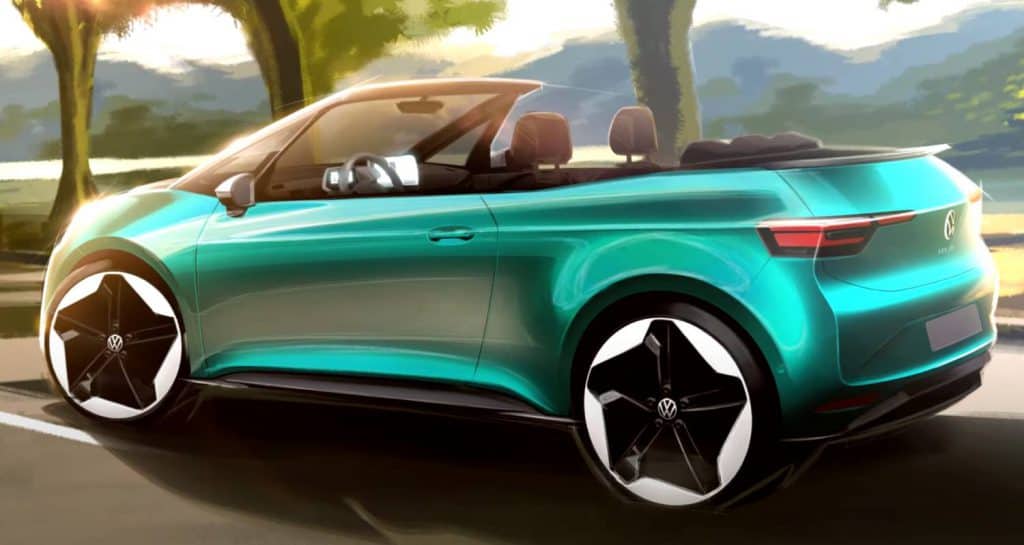In the ever-expanding world of EVs, there’s something rather interesting that stands out. Virtually none of them so far have been convertibles. This strikes us as odd because given that EVs are still in the higher-end niche of the automotive world financially, and given the proclivity of wealthier drivers to choose convertibles, it seems to make sense that there would be a healthy selection even in these early days.
In today’s blog, we’re exploring questions surrounding EV convertibles. Where are they? Why aren’t there more? Do any car makers have plans for EV convertibles in the near future?
What EV Convertibles Have Been Produced?

To date, there are only a handful of electric convertible options, and even fewer of them were all-electric BEVs. Perhaps the best-known examples are the Tesla Roadster and the Smart Fortwo Electric Drive Cabrio. The Tesla Roadster stands out because it was discontinued back in 2012 but is now once again in production for a second generation.
It seems that neither of the two models were super sellers. The Tesla only sold 2,450 units in 30 international markets, and the majority of those were outside North America. Right now, the Roadsters biggest claim to fame is that Elon Musk’s own model was launched into space and is now hurtling around the solar system.
Another well-known EV convertible was the BMW i8, but it was a PHEV that offered about 18 miles of all-electric range, but then would switch to a regular 1.5L gasoline engine with a turbocharger at about 27mpg. Besides these models, the market for convertibles in the electric vehicle sphere has been virtually non-existent.
As a part of its move to produce all electric and hybrid models by 2030, Bentley has already unveiled a hybrid version of their Bentayga SUV, but it’s not a convertible so doesn’t much to contribute to the story at this point.
Which Companies are Showing EV Convertible Concepts?
There are several auto manufacturers who have shown concept cars and other ideas for convertible EV models, but it seems none are yet in production. Below we will detail a few examples:
Tesla Roadster (Second Generation)
Since at least 2017 there has been discussion on a new generation of Tesla Roadsters. It’s hard to see exactly what will make the second generation more successful than the first, but perhaps now that Tesla has a proven track record and is among the best-selling EV brands anywhere in the world, the new Roadster will be a bigger hit.
Having said that, production plans are currently limited to only 1,000 units in 2022, after the release of the revised version of the Model S “Plaid.” The Tesla Roadster second generation will have a removable glass roof, and has some distinct styling changes compared to its first-generation counterpart. The design feels a lot more angular and is reminiscent of the Italian supercar in its lines and overall dynamic.
Musk has made some pretty interesting claims about the upcoming Roadster — no surprises there — saying that after the initial release, there will be higher-specification models available that would even include rocket thrusters! Musk says these will not only allow for huge improvements in acceleration and handling, but even open up the possibility of flight.
Nissan Leaf Convertible
Some might be surprised to learn that Nissan was returning to the world of convertibles after the humiliating experience they had with the 2013 Nissan Murano CrossCabriolet models. The interesting thing about that Murano was that it may have been received as an utter joke in showrooms brand-new, but it went on to find some success on the pre-owned car market.
In 2018, Nissan unveiled a new convertible concept, and this time for their ever-popular and all-electric Nissan Leaf. It was unveiled in Tokyo originally as a part of reaching the significant milestone at the time of 100,000 Leafs being sold. Some remarked at the unusual design of the Leaf convertible concept. It featured no rear doors — they had been welded shut — and a roll hoop roof that went behind the rear seats, which were placed so high you couldn’t see out of the back. At the same time, however, there’s an unusual allure that exists because it helps people imagine EVs as “cool” cars.
Bentley All-Electric Concept
VW-owned Bentley first showed off its all-electric concept back in 2017 in Geneva. The new all-electric Bentley is due for production in 2025 and will be among the first cars to use the all-new, state-of-the-art car luxury EV platform designed by Audi. It is set to be the first in an entirely new line of electric models that takes EV to a whole new stage in its development.
Many have already digested Bentley’s announcement and commitment to go electric by 2030, but the question on everyone’s mind now is whether these new electric vehicles will keep the same names as their combustion-based predecessors, or will it spawn an entirely new family of vehicles? The one missing element in Bentley’s story remains the convertible part. Even this new concept is not set to be convertible. What’s interesting though is that we know since Bentley is committing to go electric within 10 years that there will undoubtedly be some convertible models like the Continental GT on the horizon sooner or later.
Volkswagen ID.3 Convertible Concept

Finally, we come to perhaps the most discussed EV convertible outside of the Tesla Roadster. VW hasn’t made any kind of concrete announcement about its current rendering-only concept for an ID.3 convertible. The turquoise rendering images released by VW give pause for thought. The bold lines, contemporary alloy rims and stylish top-down design make for a very attractive automotive proposition.
VW bosses have already been on the record as declaring the VW ID.3 electric convertible a “very tempting idea,” and that they are looking at how they might integrate the model into their production line. VW CEO Ralf Brandstatter said that the ID.3 convertible “could provide an entirely new, extraordinary feeling of freedom.”
If you’re familiar with the development history of VW cars, and especially their electric cars, you might also be familiar with a previous announcement of an electric convertible, the ID Buggy. Back in 2019, Autoweek reported that a new VW electric concept was being trialed on California beaches for its potential as a fun and adventurous EV convertible option. This was actually set to go a bit further than just putting a roof up and down, however, the Buggy concept described a vehicle whose top could be fully detached and then fitted with a whole new body style. It would therefore be a much more flexible and adaptable model than the ID.3 convertible concept. Unfortunately, Brandstatter confirmed in late 2020 that the Buggy was no longer being considered for production.
Why Are There Still So Few EV Convertibles?
We’ve heard that there are indeed several companies considering the move to all-electric convertible models. The core question of today’s blog remains, however, which is why is it that to date there have been so few attempts to create a winning EV convertible? As we mentioned earlier, it seems intuitive and logical that as a naturally “higher-end” product financially, a convertible would speak to the core market who can afford the heftier price tag of an all-electric model.
It appears there are three main reasons that help to explain the lack of EV convertibles, namely:
- Weight: Cars with a drop-top roof are generally heavier than those without, which has an impact the range of an EV. When an EV has to contend with the weight of its battery pack and all the ADAS equipment and other things loaded into it, the mechanics of a convertible prove a challenge for the engineers.
- Roll Structure: Convertible cars require a much stronger roll structure than their non-convertible counterparts. This makes sense since both driver and passenger(s) are more exposed when driving a convertible. Once again, that presents challenges for the architecture of an all-electric car.
- Falling Sales: In general, sales of convertibles have been down, and that trend has been going on for years. NPR reported as long as ago as 2015 that the sales of convertibles had been in steep decline for at least the previous decade, falling by more than 40 percent. Website archyde.com also claimed that except for in the luxury segment, “the convertibles are dying out.” The main reason overall? Fuel economy.
Conclusion: Can the EV Segment Help to Revive Convertibles?
There are considerable challenges to overcome, but the fact that a group like VW is exploring the concept in earnest proves that there is something to this line of thinking. If there were nothing in it, then only the very niche luxury producers like Tesla and Bentley would touch it, but that VW considers it for its own marque as well as the luxury wing is a flame of hope for the future in EV convertibles.
As we mentioned above, the convertible remains in something of a niche even in the gasoline and diesel world. Most automakers are still working out how to produce best-selling electric sedans, hatchbacks and SUVs. It’s logical that they’d save the convertible ideas for later.
2 comments
I’m an EV Convertible buyer, just waiting to buy! But not one of the models costing the price of a house.
I can’t fault your logic, Richard! They aren’t exactly cheap right now.